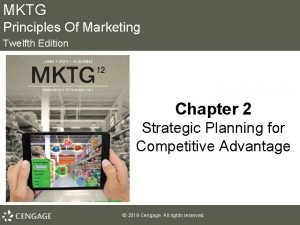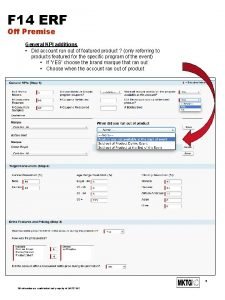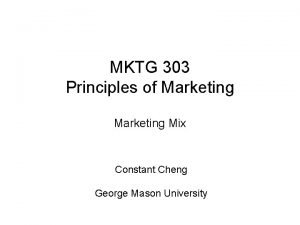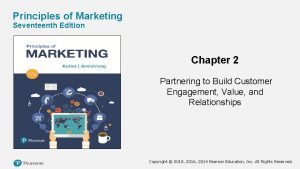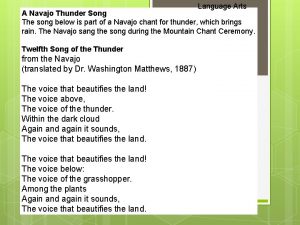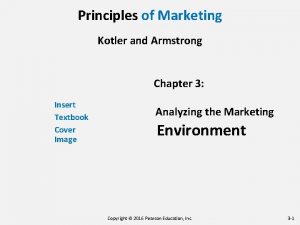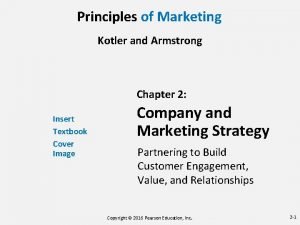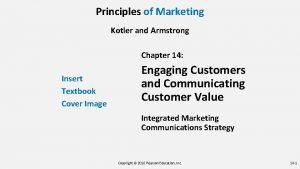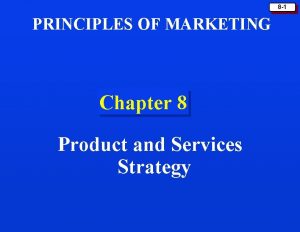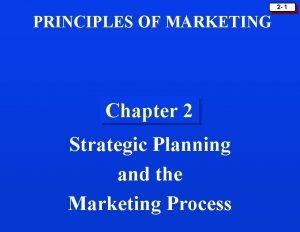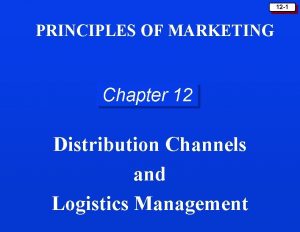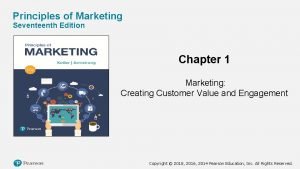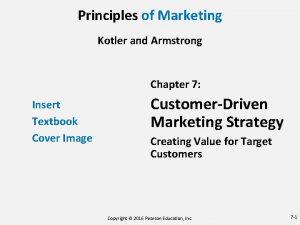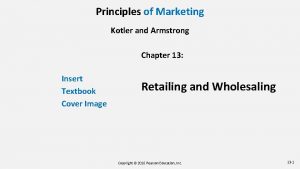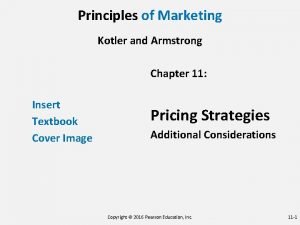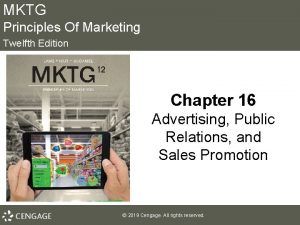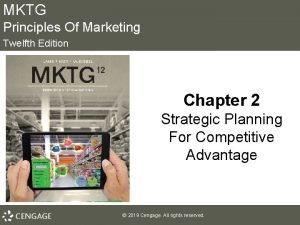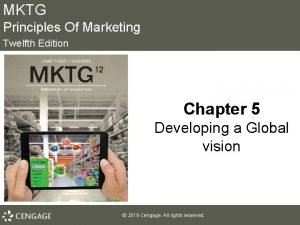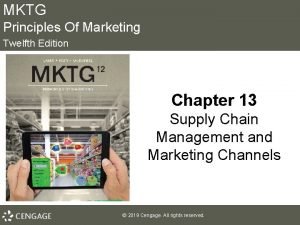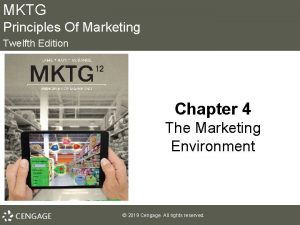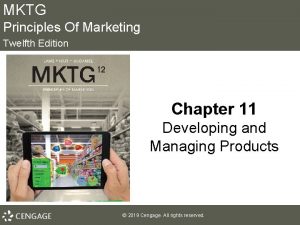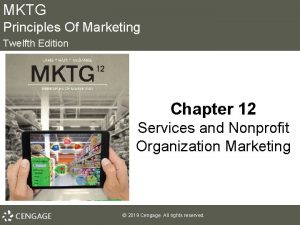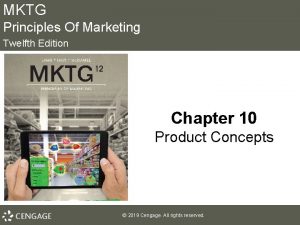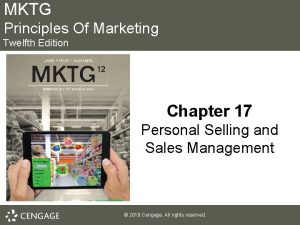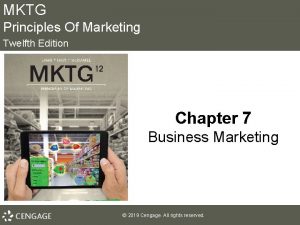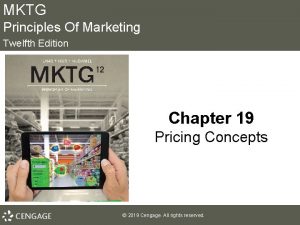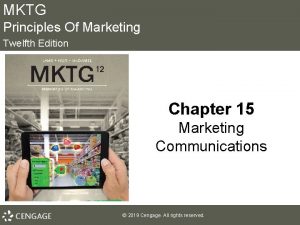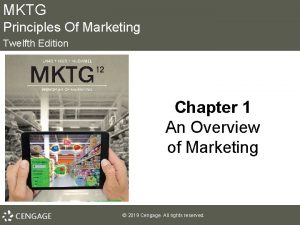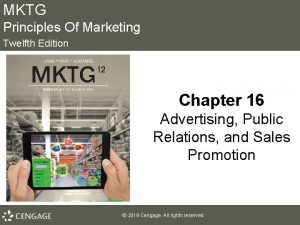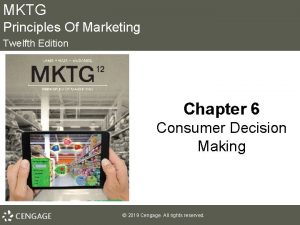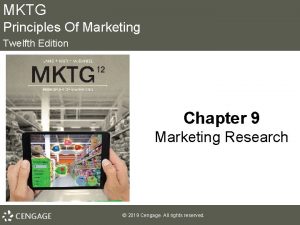MKTG Principles Of Marketing Twelfth Edition Chapter 5














































- Slides: 46

MKTG Principles Of Marketing Twelfth Edition Chapter 5 Developing a Global Vision © 2019 Cengage. All rights reserved.

Learning Outcomes 5 -1 5 -2 5 -3 5 -4 5 -5 5 -6 Discuss the importance of global marketing Discuss the impact of multinational firms on the world economy Describe the external environment facing global marketers Identify the various ways of entering the global marketplace List the basic elements involved in developing a global marketing mix Discover how the Internet is affecting global marketing © 2019 Cengage. All rights reserved.

Rewards of Global Marketing and the Shifting Global Business Landscape • • Global marketing: marketing that targets markets throughout the world Global vision: recognizing and reacting to international marketing opportunities, using effective global marketing strategies, and being aware of threats from foreign competitors in all markets – • The foundation of a successful global vision is a corporate structure that provides a continual flow of fresh ideas Global marketing is not a one-way street, foreign competitors compete in the U. S. as well © 2019 Cengage. All rights reserved.

Importance of Global Marketing to the United States • Gross domestic product (GDP): is the total market value of all final goods and services produced in a country for a given period – – • Final refers to final products that are sold, not to intermediate products used in the assembly of a final product GDP counts only final goods and services in its valuation of a country’s production More small- and medium-sized companies export goods from the United States © 2019 Cengage. All rights reserved.

Job Outsourcing and Inshoring • Outsourcing: sending U. S. jobs abroad – • Leads to corporate growth, efficiency, productivity, and revenue growth Inshoring: returning production jobs to the United States – – Rapid consumer product innovation forces the need to keep product designers, marketing researchers, logistic experts, and manufacturers in close proximity Shrinking development and manufacturing timelines have further contributed to inshoring © 2019 Cengage. All rights reserved.

Benefits of Globalization • • • Expands economic freedom Spurs competition Raises a nation’s productivity and living standards if it opens itself to the global market Offers access to foreign capital, global export markets, and advanced technology Promotes higher labor and environmental standards Acts as a check on government power © 2019 Cengage. All rights reserved.

Costs of Globalization • • Countries restrict trade and create barriers to boost exports and limit imports Globalization leads to people being laid off from their jobs – – Workers do not always find jobs in other industries Payments made to workers who have lost their jobs to foreign competition is called trade adjustment assistance © 2019 Cengage. All rights reserved.

Multinational Firms • Multinational corporation: a company that is heavily engaged in international trade, beyond exporting and importing – • Moves resources, goods, services, and skills across national boundaries without regard to the country in which its headquarters is located Stages of multinational global business development: – – Operate in one country and sell into others Set up foreign subsidiaries to handle sales in one country Operate an entire line of business in another country Engage in virtual operation © 2019 Cengage. All rights reserved.

Are Multinationals Beneficial? • • • The role of multinational corporations in developing nations is a subject of controversy Ability of multinationals to tap financial, physical, and human resources from all over the world and combine them economically and profitably can benefit any country Capital intensive: using more capital than labor in the production process Does not substantially increase employment Political pressure also causes some U. S. multinationals to bring production back home © 2019 Cengage. All rights reserved.

Global Marketing Standardization • • Global marketing standardization: production of uniform products that can be sold the same way all over the world Multidomestic strategy: when multinational firms enable individual subsidiaries to compete independently in domestic markets – Companies with separate subsidiaries in other countries can be said to operate using a multidomestic strategy © 2019 Cengage. All rights reserved.

Discussion Point Global Marketing Standardization • Consider the following companies and products: – – – Pizza Hut Crest toothpaste Head and Shoulders shampoo Coca-Cola Ikea Frito-Lay Which global marketing strategy is being used: global marketing standardization or a multidomestic strategy? © 2019 Cengage. All rights reserved.

Culture • • Culture is the common set of values shared by the citizens of a society that determines what is socially acceptable Culture underlies the family, the educational system, religion, and the social class system – – – Cultural blunders lead to misunderstandings and perceptions of rudeness or even incompetence Language is an important aspect of culture Each country has its own unique customs and traditions that determine business practices and influence negotiations with foreign customers © 2019 Cengage. All rights reserved.

Economic Factors • • In general, complex and sophisticated industries are found in developed countries and basic industries are found in less developed nations Gross national income (GNI) per capita is one measure of the ability of a country’s citizens to buy various goods and services Balance of trade: the difference between the value of a country’s exports and the value of its imports over a given period Balance of payments: the difference between a country’s total payments to other countries and its total receipts from other countries © 2019 Cengage. All rights reserved.

The Global Economy • In the past, the size of the U. S. economy was so large that global markets tended to move up or down depending on its health – • Still true today, but less so than in the past Unfortunately, politics is playing an increasingly important role in the development of the BRICS countries (Brazil, Russia, India, China, and South Africa) © 2019 Cengage. All rights reserved.

Political Structure and Actions • • Government policies run the gamut from no private ownership and minimal individual freedom to little central government and maximum personal freedom Regulation gives businesses the framework they need to grow and prosper Regulation can overburden businesses and make it virtually impossible for them operate International politics can affect business laws © 2019 Cengage. All rights reserved.

Legal Considerations (slide 1 of 2) • Many legal structures are designed to either encourage or limit trade – Tariff: a tax levied on goods entering a country – Quota: a limit on the amount of a specific product that can enter a country – Boycott: the exclusion of all products from certain countries or companies – Exchange control: a law compelling a company earning foreign exchange from its exports to sell it to a control agency © 2019 Cengage. All rights reserved.

Legal Considerations (slide 2 of 2) – Market grouping (also known as a common trade alliance): occurs when several countries agree to work together to form a common trade area that enhances trade opportunities – Trade agreement: an agreement to stimulates international trade § Mercosur: the largest Latin American trade agreement; includes Argentina, Bolivia, Brazil, Chile, Columbia, Ecuador, Paraguay, Peru, Uruguay, and Venezuela © 2019 Cengage. All rights reserved.

Discussion Point Legal Considerations • Have the class research examples of each of the following: – – – Tariff Quota Boycott Exchange control Market grouping Trade agreement What were the impacts of each legal consideration? Was it effective? © 2019 Cengage. All rights reserved.

The Uruguay Round, the Failed Doha Round, and Bilateral Agreements (slide 1 of 3) • Uruguay Round: a trade agreement that has dramatically lowered trade barriers worldwide, created the World Trade Organization – Adopted in 1994, the agreement has been signed by 162 nations • For the first time, a trade agreement covers services, intellectual property rights, and trade-related investment measures such as exchange controls © 2019 Cengage. All rights reserved.

The Uruguay Round, the Failed Doha Round, and Bilateral Agreements (slide 2 of 3) • The Uruguay Round made several major changes in the world trading practices: – – – Entertainment, pharmaceuticals, integrated circuits, and software Financial, legal, and accounting services Agriculture Textiles and apparel A new trade organization: § World Trade Organization (WTO): a trade organization that replaced the old General Agreement on Tariffs and Trade (GATT) § General Agreement on Tariffs and Trade (GATT): a trade agreement that contained loopholes enabling countries to avoid trade-barrier reduction agreements © 2019 Cengage. All rights reserved.

The Uruguay Round, the Failed Doha Round, and Bilateral Agreements (slide 3 of 3) • Latest round of WTO trade talks began and Doha, Qatar in 2001 – After 14 years of talks, WTO members ended the Doha Round of negotiations – The talks were paralyzed because neither developed economies nor developing countries were willing to make fundamental concessions • Trade Facilitation Agreement (TFA): a World Trade Organization agreement that aims to cut customs-related red tape and ease the flow of trade between countries © 2019 Cengage. All rights reserved.

North American Free Trade Agreement • North American Free Trade Agreement (NAFTA): an agreement between Canada, the United States, and Mexico that created the world’s then-largest free trade zone – • NAFTA has resulted in many low-skilled and assembly line jobs moving from the United States to Mexico Foreign direct investment: a business investment in a foreign country, either by establishing business operations or by acquiring business assets in that country © 2019 Cengage. All rights reserved.

Dominican Republic–Central America Free Trade Agreement • Dominican Republic-Central America Free Trade Agreement (CAFTA-DR): a trade agreement instituted in 2005 that includes Costa Rica, the Dominican Republic, El Salvador, Guatemala, Honduras, Nicaragua, and the United States – – As of 2015, all consumer and industrial goods exported to CAFTA-DR countries are no longer subject to tariffs The agreement also covers intellectual property rights, transparency, electronic commerce, and telecommunications © 2019 Cengage. All rights reserved.

European Union • European Union (EU): a free trade zone encompassing 28 European countries – – • • One of the world’s most important free trade zones More than just a free trade zone, it is also a political and economic community EU guarantees the freedom of movement of people, goods, services, and capital between member states Maintains a common trade policy with outside nations and a regional development policy © 2019 Cengage. All rights reserved.

The World Bank, the International Monetary Fund, and the G-20 • • • World Bank: an international bank that offers lowinterest loans to developing nations International Monetary Fund (IMF): an international organization that acts as a lender of last resort, providing loans to troubled nations, and also works to promote trade through financial cooperation Group of Twenty (G-20): a forum for international economic development that promotes discussion between industrial and emerging-market countries on key issues related to global economic stability © 2019 Cengage. All rights reserved.

Exhibit 5. 3 Members of the G-20 Argentina European Union Italy South Africa Australia France Japan Republic of Korea Brazil Germany Mexico Turkey Canada India Russia United Kingdom China Indonesia Saudi Arabia United States © 2019 Cengage. All rights reserved.

Demographic Makeup • • Two primary determinants of any consumer market are wealth and population Three groups will generate about half the world’s consumption growth: – – – Retiring and elderly in developed countries China’s working age population North America’s working age population © 2019 Cengage. All rights reserved.

Natural Resources • Vast differences in the locations and quantities available of natural resources create: – – – International dependencies Huge shifts of wealth Inflation and recession Export opportunities if resources are abundant Stimulus for military intervention © 2019 Cengage. All rights reserved.

Global Marketing by the Individual Firm • • A company should consider entering the global marketplace only after its management has a solid grasp of the global environment Firm’s “go global” for a number of reasons: – – – • Earn additional profits Offer a unique product or technological advantage not available to international competitors Saturated domestic markets Excess capacity Potential for economies of scale Many firms form multinational partnerships called strategic alliances © 2019 Cengage. All rights reserved.

Methods of Entering the Global Market (slide 1 of 3 ) • Exporting: selling domestically produced products to buyers in other countries – Buyer for export: an intermediary in the global market that assumes all ownership risks and sells globally for its own account – Export broker: an intermediary who plays the traditional broker’s role by bringing buyer and seller together – Export agent: an intermediary who acts like a manufacturer’s agent for the exporter; the export agent lives in the foreign market © 2019 Cengage. All rights reserved.

Methods of Entering the Global Market (slide 2 of 3 ) • Licensing: the legal process whereby a licensor allows another firm to use its manufacturing process, trademarks, patents, trade secrets, or other proprietary knowledge – – Franchising is a form of licensing whereby a franchisee pays a one-time fee and a percentage of sales to the franchisor for the opportunity to sell the company’s goods or services Some franchises have to adapt to local cultures © 2019 Cengage. All rights reserved.

Methods of Entering the Global Market (slide 3 of 3 ) • • • Contract manufacturing: private-label manufacturing by a foreign company Joint venture: when a domestic firm buys part of a foreign company to create a new entity Direct investment occurs when a business in one country invests in a business interest in another country © 2019 Cengage. All rights reserved.

5. 4 Exhibit 5. 4 Risk Levels for Five Methods of Entering the Global Marketplace © 2019 Cengage. All rights reserved.

The Global Marketing Mix • • The first step in creating a marketing mix is developing a thorough understanding of the global target market Marketing research can help gather this knowledge – Global marketing research can be difficult © 2019 Cengage. All rights reserved.

Product Decisions • Some of the product decision strategies are: – – – One product, one message: developing a single product for all markets Product invention: either creating a new product for a market or drastically changing an existing product Product adaptation: altering a basic product to meet local conditions © 2019 Cengage. All rights reserved.

Promotion Adaptation • • Maintain the same basic product but alter the promotional strategy Language barriers, translation problems, and cultural differences have generated numerous headaches for international marketing managers © 2019 Cengage. All rights reserved.

Place (Distribution) • • • Solving promotional and product problems does not guarantee global marketing success Adequate distribution is necessary for success in global markets Distribution decisions may need to be altered for each foreign market © 2019 Cengage. All rights reserved.

Pricing • • Pricing presents unique problems in the global sphere Marketers must: – – – • Consider transportation costs, insurance, taxes, and tariffs Determine how much customers are willing to spend on a particular product Ensure that foreign buyers will pay the price Marketers may need to simplify a product to lower the price – Should not assume that low-income countries are willing to accept lower quality © 2019 Cengage. All rights reserved.

Exchange Rates • Exchange rate: the price of one’s country’s currency in terms of another country’s currency. – If a country’s currency appreciates, less of that country’s currency is needed to buy another country’s currency and vice versa • Floating exchange market rates: a system in which prices of different currencies move up and down based on the demand for and the supply of each currency © 2019 Cengage. All rights reserved.

Dumping • • Dumping: the sale of an exported product at a lower price than that charged for a similar product in the “home” market of the exporter May occur as a result of exporter business strategies that include: – Trying to increase an overseas market share – Temporarily distributing products to overseas markets to offset slack demand at home – Lowering unit costs by exploiting large-scale production – Attempting to maintain stable prices during periods of exchange rate fluctuations © 2019 Cengage. All rights reserved.

Countertrade • Countertrade: a form of trade in which all or part of the payment for goods or services is in the form of other goods or services – – • A form of barter Fast-growing way to conduct global business One common type of countertrade is straight barter © 2019 Cengage. All rights reserved.

The Impact of the Internet • • • Opening an e-commerce site puts a company in the international marketplace Internet-based economy remains hindered by brickand-mortar rules, regulations, and habits. Global marketers use social media: – – – Because it is popular around the world To understand customers For global brand building © 2019 Cengage. All rights reserved.

Key Terms (slide 1 of 4) • • • Global marketing Global vision Gross domestic product (GDP) Outsourcing Inshoring Multinational corporation Capital intensive Global marketing standardization Multidomestic strategy Balance of trade Balance of payment © 2019 Cengage. All rights reserved.

Key Terms (slide 2 of 4) • • Mercosur Uruguay Round World Trade Organization (WTO) General Agreement on Tariffs and Trade (GATT) Trade Facilitation Agreement (TFA) North American Free Trade Agreement (NAFTA) Foreign direct investment Dominican Republic-Central America Free Trade Agreement (CAFTA-DR) © 2019 Cengage. All rights reserved.

Key Terms (slide 3 of 4) • • • European Union (EU) World Bank International Monetary Fund (IMF) Group of Twenty (G-20) Exporting Buyer for export Export broker Export agent Licensing © 2019 Cengage. All rights reserved.

Key Terms (slide 4 of 4) • • Contract manufacturing Joint venture Direct foreign investment Exchange rate Floating exchange rates Dumping Countertrade © 2019 Cengage. All rights reserved.
 Mktg 12th edition
Mktg 12th edition Mktg 12th edition
Mktg 12th edition Principles of marketing chapter 9
Principles of marketing chapter 9 Management 12th edition griffin
Management 12th edition griffin Undifferentiated targeting strategy
Undifferentiated targeting strategy Mktg emc
Mktg emc Differences between games and sports
Differences between games and sports Cheng, constant
Cheng, constant Mktg 10
Mktg 10 Principles of marketing fifth european edition
Principles of marketing fifth european edition Principles of marketing arab world edition
Principles of marketing arab world edition Chapter 2 principles of marketing
Chapter 2 principles of marketing Principles of marketing module 1
Principles of marketing module 1 Using mis (10th edition) 10th edition
Using mis (10th edition) 10th edition Zulily case study
Zulily case study One face one voice one habit and two persons
One face one voice one habit and two persons Twelfth night ppt
Twelfth night ppt Twelfth night poem
Twelfth night poem Twelfth night characters
Twelfth night characters Dramatic conventions
Dramatic conventions Twelfth night act 1 scene 5 translation
Twelfth night act 1 scene 5 translation Duke orsino
Duke orsino Themes in twelfth night
Themes in twelfth night Language
Language Twelfth night act 5
Twelfth night act 5 Setting of twelfth night
Setting of twelfth night Jenny phelps
Jenny phelps The twelfth of never
The twelfth of never Satire in twelfth night
Satire in twelfth night Deverell twelfth night
Deverell twelfth night Disappeared silent night
Disappeared silent night Ironic and humorous plays
Ironic and humorous plays Chapter 7 marketing
Chapter 7 marketing Marketing chapter 5
Marketing chapter 5 Principles of marketing test bank chapter 3
Principles of marketing test bank chapter 3 Principles of marketing ppt chapter 2
Principles of marketing ppt chapter 2 Integrated marketing communication ppt kotler
Integrated marketing communication ppt kotler Principles of marketing chapter 8
Principles of marketing chapter 8 Principle of marketing chapter 2
Principle of marketing chapter 2 Marketing chapter 12
Marketing chapter 12 Principles of marketing chapter 3
Principles of marketing chapter 3 Creating customer relationships and value through marketing
Creating customer relationships and value through marketing Principles of marketing chapter 7
Principles of marketing chapter 7 Principles of marketing chapter 13
Principles of marketing chapter 13 Principles of marketing chapter 17
Principles of marketing chapter 17 Principles of marketing chapter 14
Principles of marketing chapter 14 Marketing chapter 11
Marketing chapter 11
